The J. K. Brick Retort & Fire Brick Works established in 1854 was one of the earliest industrial establishments in Red Hook. It was shown on the 1869 map on either side of VanDyke between Van Brunt and Richards. It was indicated on subsequent maps. The buildings are still standing.
The company was still in business in 1943.
Joseph K Brick was born in New Jersey and educated in Philadelphia. He came to Brooklyn around 1848 to superintend the Brooklyn Gas Light Company works. He may have established the Clay Retort and Fire Brick works to provide clay retorts for the gas works.Brooklyn Clay Retort and Fire Brick Works was indicated on the 1886 Ward 12 map as "Brooklyn Fire brick Works" and as "Fire Brick store". They advertised in the 1886 Brooklyn directory as BROOKLYN CLAY RETORT AND FIRE BRICK WORKS, 88 VAN DYKE STREET, BROOKLYN
They advertised in the 1897 Brooklyn Eagle Almanac as "dealers in Ground Fire Clay, Ground Fire Brick, Fire Mortar, Kaolin, Fire Sand, etc." Office 88 Van dyke Street, Brooklyn.
According to other ads they were "manufacturers of high grade refractories, fire brick and special shapes for power plants and the metallurgical, chemical and enameling industries" as well as manufactures of "clay retorts, Fire Brick and Tile and dealers in Ground fire clay, ground fire brick, fire mortar, Kaolin, Fire sand etc." and "MANUFACTURERS OF Fire Brick, Tile, Stove and Range Linings, Cupola Blocks and Clay Retorts".
Their fire bricks were used to line industrial furnaces: brick and pottery kilns, lime kilns, cement kilns, smelting furnaces and rolling mills. The bricks were made from "fire clay" which was found in local deposits.
In 1863 the Clay Banks of the J. K. Brick Estate were in Sayreville township, New Jersey, where a quarter of a mile exposed strada ran along the eastern and northeastern side of a ridge. The clay was in layers of various types and classes. S. Gildersleeve was the superintendent for these works.
In 1876 the following sources were listed for J. K. Brick:
In 1877 and 1878 the following sources were listed: "J. K. Brick estate, bank Washington, top of kaolin", "J. K. Brick estate, bank, bottom of fire clay" South of the Raritan River. See State of New Jersey Clay Deposites
- BLUD FIRE CLAY: J. K. Brick estate, Burt's creek, South Amboy, Middlesex co.
- FIRE CLAY: J. K. Brick estate, Burt's creek, South Amboy, Middlesex co.
- BUFF CLAY J. K. Brick estate, Burt's creek, South Amboy, Middlesex co.
- RED CLAY J. K. Brick estate, Burt's creek, South Amboy, Middlesex co.
- CLAY (for pottery) Western pits; Burt's creek, South Amboy, Middlesex co.
(Catalogue of the centennial exhibit of the geological survey of new jersey.)
In 1879:
"The South Amboy fire-clay bed is opened in several very large pits or excavations on the south side of the Raritan River. The pits of E. F. & J. M. Roberts, George Such, J. K. Brick estate, Whitehead Bros., and Sayre & Fisher, are in it, and they sell annually many thousands of tons of superior fire-clay."The clay was shipped on the Raritan River to the Erie Basin.(Transactions, Volume 6 By Metallurgical Society of AIME.)
The fire brick and retort "works" in Brooklyn were located at Van Dyke, Elizabeth and Richards Streets near a land entrance to the Erie Basin. A Brooklyn Fire Brick warehouse build in 1859 still stands on Van Dyke street.
Joseph Brick is credited with being the first company to manufacture clay retorts in the United States. In the retort coal was heated to produce gas used for illumination and it made the production of illuminating gas economically feasible. The retorts were used in the production of illuminating gas by firms such as the Brooklyn Gas Light Company.
"Illuminating gas is made by subjecting bituminous coal to a red heat in a tight retort for the space of five hours, during which time the coal is decomposed and the gas is driven off through a pipe which communicated with the retort."Landmark Preservation Commission December 18, 2001 Designation List 332, LP-2108 contains a lot of information of fire brick, clay retorts and the history of the Brooklyn Fire Brick works.1859 Scientific American
Steps in making fire brick included: selecting and mixing the clays, washing the clay, grinding and tempering the clay, mixing, molding, pressing, drying and burning the bricks. Molding and pressing by hand was labor intensive. Many attempts were made to mechanized molding and pressing but the job was better done by hand. Brick making was considered a trade.
Time Line
1854: Brooklyn Fire Brick Works at 88 Van Dyke Street was established 1854 by Joseph K. Brick.
1856: The American Institute of the City of New York Fair "Brooklyn Fire-Brick Works, J. K. Brick & Co., Brooklyn, L. I., for the best fire-brick and retort. Silver medal."
1859: About 1859 Edward D. White, born in Brooklyn March 1, 1822, became a partner of Joseph K. Brick in the Fire Brick Works.
1860: J. K. Brick & Co., Brooklyn, L. I., for very fine specimens of clay gas retorts. (A silver medal having been before awarded.) Diploma. (Annual report THE AMERICAN INSTITUTE, OF THE CITY OF NEW YORK)
1860: George E. Bennett, born in Brooklyn September 12, 1844, became an associate of the Brooklyn Fire Works in 1860. He worked for the company for 29 years. He was the foreman of the company for ten years.
1861: March, There was a small "riot' on the corner of Van Brunt and Van Dyke after an attempt to reduce wages at the J. K. Brick brick yard. The "mob" of some 15 to 20 men and women armed with clubs threatened to tar and feather the forman of the works, Zenor Parrish. Some sort of a petition had been signed by a number of the brick works laborers. J. K. Brick discharged all the men who had signed the petition. Zenor Parrish was beaten up by the mob. A pistel shot was fired but no one was hurt. There were 13 defendants included: Charles Baumann, Philip Schneider (or Schnelder), Mary Frederika Muller (or Mullen), Louis Guff, Henry Huff (or Nuff) and/or Lewis Huff . Apparently a lot of the comments thrown around among the participants were in German. Zenor Parrish said he had been the foreman in the brick yard for about 5 or 6 months. Charles W. Kennedy was listed as an engineer at the works. August Lamtle (?) (Lamile) said he was a foreman of the retort factory in the brick yard A related article said that the parties in the riot were all Germans and belonged to the same singing society from which Zenor Parrish had been expelled. Hence Zenor Parrish had a ax to grind and took his revenge by having them all fired.
1867: Joseph K. Brick died in 1867. He had no living children. He left everything to his widow, Julia, but his brothers and a sister contested the will. His estate was litigated over for years - ending up in the Supreme Court of the District of Columbia. Julia's will was also contested after her death.
1867:
Mr. Edward D. White associated himself with Mr. Brick in 1859 and upon Mr. Brick's death in 1867 the firm name was changed to Edward D. White & Co., and was continued in that style until the incorporation of the business under the title of the Brooklyn Fire Brick Works, in 1893, Mr. White retaining his interest in the business and the official position of vice-president, transferring the managing direction of the company to Mr. A. H. Gutkes, president, and Mr. F. P. Morgan, secretary, both of whom are well qualified by experience and ability to follow out the lines along which the establishment has been so successfully conducted during the period of a third of a century, and to attain new successes as well. Perhaps the best example of promise in this direction is shown by the order that was recently given the Brooklyn Fire Brick Works by the Consolidated Gas Company of this city for all the retorts, fire brick, tiles, shapes and every other material of like nature that the Consolidated Company will require during 1894. Such an order as this will run well up into the thousands of dollars and must be considered a marked evidence of the high appreciation of the Brooklyn Company's products in face of the fact that heretofore the Consolidated Company has divided its business between several fire brick concerns. It is really a matter of some moment to know that this excellent establishment proposes to extend its business wherever a demand exists for its product.1867: The name of the firm was changed to Edward D. White & Co. Fire-Brick Works.Gas Age vol 12, 1894
1891: While playing in front of his house Alfred Watkelson, age 3, of 351 Van Brunt was run over and killed by a wagon belonging to Edward White of 88 Van Dyke Street. The wagon was driven by Anthony Klein of 194 12th street who was arrested.
1893: "Dissolution of Partnership, between, Edward D. White, Ira N Stanley and Julia E Brick under the firm name of Edward D White & Co. in the business of manufacturing and selling clay retorts, fire brick, tile etc. was disolved by mutual consent." (BE)
1894:
We believe to Joseph K. Brick should be given the credit for the production of the first clay gas retorts made in this country. Away back in the early fifties Mr. Brick acquired a considerable tract of land in what was known as the Erie Basin, South Brooklyn, upon which be erected suitable buildings and commenced to turn out fire brick and tiles. Mr. Brick began in a small way, but the superior quality of his products soon attracted wide attention and it was not long ere he found it necessary to add materially to his facilities. The superior clays and manipulation enjoyed by the Brick establishment contributed to its success in the manufacture of gas retorts.1895: The Board of Directors of the "Brooklyn Fire Brick company" at 88 Van Dyke street was: Edward D White. Seth L Keeney, David H Valentine, Daniel J Creem, August H Gutkes, Fredrick T Aldridge and William Beard.Gas Age Vol 12, 1894
1895: F. P. Morgan of the Fire Brick Works announced that the business was reviving, there were in influx in orders, and the future was bright.
1897: Van Dyke st n cor Richards st runs n e 125 x w 100 to Van Dyke st x s e 150, Julia B Brick to Brooklyn Fire Brick Works $3,000
1897:
BROOKLYN FIRE-BRICK WORKS, after a profitable and constantly increasing existence of more than forty years, has just added to its extended line of fire clay products, the manufacture of stove lining brick.The great demand of the New York trade has for a long time been somewhat hindered by the want of a factory for the making of stove linings near to this growing center of business. To meet and supply this long-felt necessity a consolidation of the Stamford Stove Lining Works and the Brooklyn Fire Brick Works has been perfected.
......
In 1867 Mr. Brick died, and the name of the firm was changed to Edward D. White & Co. Fire-Brick Works. Under the new title the business still continued to grow and maintained its well-earned reputation, by always making only the best. In 1893 the business was incorporated under the designation of the Brooklyn Fire-Brick Works, the name it is now known by. The present officers of the company are: Edward D. White, President; A. H. Gutkes, Vice-president; H. A. Perkins, Secretary.
The present works are very large, covering an entire square, fronting on Van Dyke and Elizabeth streets and the Erie basin, the office building and the warehouses being upon the opposite square on Van Dyke street. All the buildings are constructed of stone, brick and iron, and are almost fireproof. All the kilns are within the buildings and are of a most substantial character, some of them being more than thirty years old and still in perfect condition. The works are under tile superintendence of Mr. Frank E. Reder, who has grown up with the works and is well posted in all that relates to the management of the plant and the erection of such retorts and mufiies as are made here.
Everything about these works, from the machinery to the kilns and storage, is of the best and most permanent character, the facilities for working, the convenience of handling, and the comfort of the employes being all thoroughly provided for.
There are large fans for ventilation and drying, a large plunge bath room with hot and cold water and clean towels for the use of the workmen at the close of the working day. Cleanliness in the workshop and in the workmen is expected and enforced. The drinking water passes through a long coll of pipe packed in ice, so that it is cold and pure, the very questionable practice of a common cup dipping into a tank of iced water being thus avoided. There are many old employes found in each of the departments, an evidence that this company recognizes a spirit of mutual interest, which the past and present management have found to be an incentive to faithful service and good work, which alone can insure to any concern the highest and best quality of product.
The varied products of the Brooklyn Fire-Brick Works are in demand and are shipped to widely separated points, reaching from Maine to Oregon, and through all that vast territory they demand and receive the best prices paid in the market for fire-clay goods.
The motto of this company has ever been, and under the new management of H. A. Perkins will surely be, "Attend strictly to your own business. Make only the best. Good prices follow."
The Clay Worker, Volumes 27-28, 1897
1900 Fire in a Brick Factory
There was a fire at the Brooklyn Fire Brick works on February 9, 1900 around 9 o'clock at night.Police Captain Cullen of the Hamilton avenue station sent twenty-five men from his command to control the crowds. There were some interesting features in connection with the fire. The Elizabeth street dock was blocked in such a way that it seemed impossible for any craft to land there, but notwithstanding this the two fire boats, Seth Low and New Yorker, crowned on steam in a race for the slip. But when they reached that point there was considerable delay in trying to clear the blockade.The Seth Low managed to "get the first steam on the fire".The fire extended to the three story frame dwelling at 115 Van Dyke owned by Lizzie Marrion of 19 Oakland Street, driving out all tenants.The loss to Brooklyn Fire Brick was estimated at $100,000. This included damage to the building, damage to machinery and loss of patterns. The company was insured. The fire was gotten under control by midnight. Two hundred and fifty "persons" were thrown out of work by the fire, there was loss of personal property and furniture by several uninsured tenants of 115 Van Dyke.Brooklyn Eagle and New York Times February 10, 1900.
1900: Fire at the brick works. Three alarm fire; cased by over heated kiln in the southwest corner of the large brick and granite building on Van Dyke streets. At the time the works were reported to have employed 250 men. The structure was entirely gutter, only the walls were left standing. The retort, stove lining stock, office building, engines and boilers were saved.
1900: Van Dyke st s s 25 W Richards st repair damages by fire on factory; cost, $--,000 Brooklyn fire Brick Works on premises, architect and builder D. J. Lynch 97 Coffey st. (BE)
1901: Brooklyn fie Brick Works directors: Edward d. White, David H. Valentine, Daniel J Creen, August H Gutkus, Frank A Keeney, Edward L Rice, and William Beard
1903, Sanitary and heating age
The Brooklyn Fire Brick Works, 88 Van Dyke street, Brooklyn, N. Y., are manufacturers of Stove and Range Linings of all kinds as well as Fire Brick. Cupola and Brass Furnace Blocks. The concern also make a specialty of Muffles for enameling works.1903: frame shed, 12x70; cost $75; Brooklyn Fire Brick Works, 88 Van Dyke st. (BE)
Brickmakers, the laborers
There was a brickmakers strike in Verplank, New York in 1890. Among the jobs associated with brick makeing the following were listed: pit shovelers, dumpers, sanders, molders, truckers, brick setters, brick wheeler, teamsters, bank men - in order of their pay scale with shovelers promised $2.37 per day and bank men making $1.87 per day. Wagers were slightly higher at the Haverstraw brick works. The brick yard workers were described as: "a rough, honest, hardy lot of men".
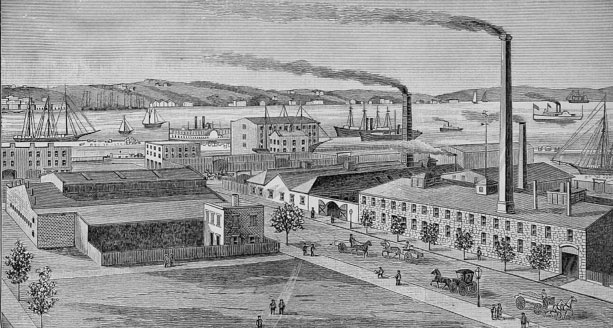
Illustration form Henry Stiles History of Brooklyn
The building erected in 1854-59 is still standing at 76-86 Van Dyke Street. See A Preservation Plan For Red Hook 2009
This view is looking from the north west towards the south east, with the Erie Basin in the background. However the relationship of the buildings to the water is not accurate.
The building with the chimneys was the location of the kilns. The complex included a boiler room, a steam engine room, kilns,
carpenters shop, clay mixing room, storage, coal bins, a stables, and room to house the patters and molds for
the various shapes and sizes of the bricks. The two story building next to the storehouse was an office.
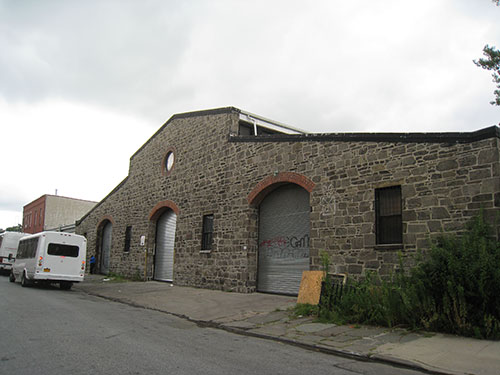
Photo Maggie Land Blanck August 2012
The storehouse of the Brooklyn Fire Brick Works. There is a 2002 Designated Landmark New York City plaque on this building which reads:
THE BROOKLYN CLAY RETORT AND FIRE BRICK WORKS STOREHOUSEI think it is curious that the building which housed a brick works was built of stone - especially since so many of the other buildings in the neighborhood were built of brick. Stone was not typically used in the construction of industrial buildings in the New York area.Built during the early days of Red Hook's shipping and industrial development, the Brooklyn Clay Retort and Fire Brick Storehouse is a significant mid-nineteenth century industrial building. The company was founded by the aptly-named Joseph K Brick in 1854 to manufacture "retorts" - vessels in which coal was heated to produce illuminating gas -- and to manufacture refractory, or "Fire" Bricks. The storehouse, designed by Brick circa 1859, has the distinctive basilica form of mid and late nineteenth century industrial workshops. Constructed of rough-hewn, square cut local dark grey schist and detailed with brick and sandstone, the storehouse features a clerestory of windows, skylights and a bull's eye window on its Van Dyke Street Facade. Restored by Gregory O'Connell in 1995-96, this rare example of an early stone industrial building is the first designated New York City landmark in Red Hook.
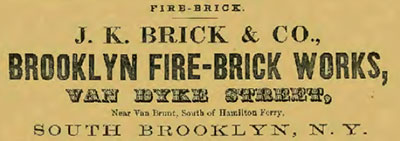
1858 ad from the Brooklyn Eagle
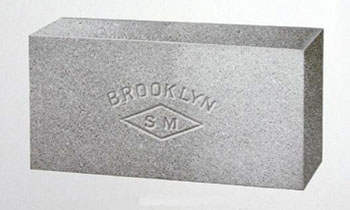
Brooklyn Fire Brick
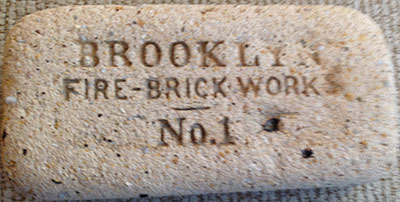
Brooklyn Fire Brick date unknown. In December 2015 Richard Frenkiel sent the above image and
said:
"I found this today on the beach at the southern end of Long Beach Island (near Atlantic City), and was fascinated enough to carry it home (3 miles). It looks like it spent a lot of time getting here from somewhere, and I wondered why a brick like this would be inscribed in this way in the first place. I found your article on the web and thought you might be interested."
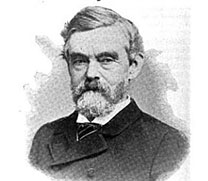
The Clay Worker Vol 27-28, 1897
Edward D White, President Brooklyn Fire Brick Works

The Clay Worker Vol 27-28, 1897
Officer of the Brooklyn Fire Brick Co, H. A. Perkins, Secretary, A. H. Gutkes, Vice President,
Frank Reeder, Supt.
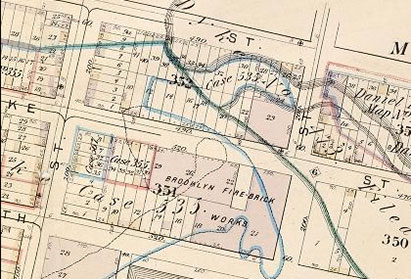
1880 map NY Public Library
The 1880 Map shows: the stone and brick basilica style building at the corner of Richards and the north side of Van Dyke, a stone and brick building and a brick building along the south side of Van Dyke.
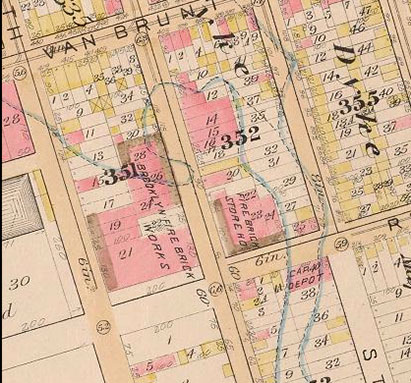
1886 map NY Public Library
The 1886 Map shows: the stone and brick basilica style building at the corner of Richards and the north side of Van Dyke, a stone and brick building and a brick building along the south side of Van Dyke.
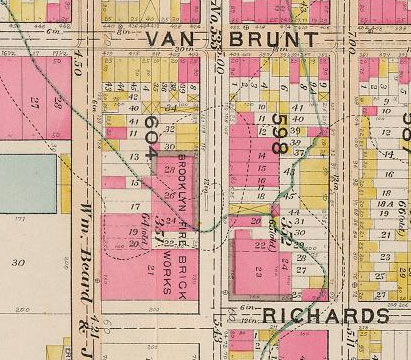
1898/99 map NY Public Library
The 1886 Map shows: the stone and brick basilica style building at the corner of Richards and the north side of Van Dyke (labeled as a storehouse), a stone and brick building and a brick building along the south side of Van Dyke.
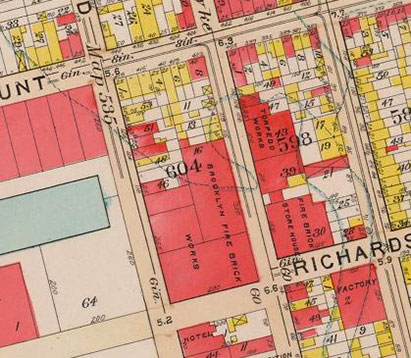
1907 map NY Public Library
The 1907 Map shows: the stone and brick basilica style building at the corner of Richards and the north side of Van Dyke (labeled as a storehouse), a stone and brick building and a brick building along the south side of Van Dyke.
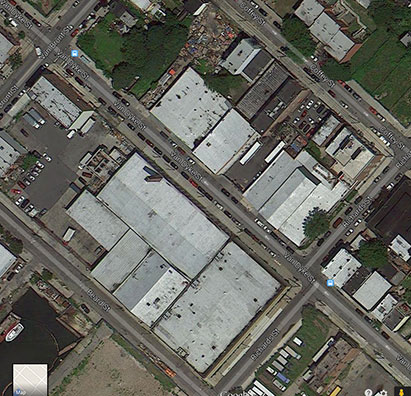
1898/99 map NY Public Library
The 2103 Google Map shows pretty much the same configuration of buildings seen in the 1880 map.
Joseph Keasbey Brick (1812-1867) and Julia Brewster Brick (1819- 1902)
Birth: 1812 son of Joseph and Elizabeth (Smith) Brick, Woodlawn, N. J.Bennett, GeorgeMarriage 1844: Julia Elma Brewster born 1819 Brooklyn to Horace Brewster and Lydia
Died: Hot Springs Ark. Aug 7, 1867
He was survived three brothers, a sister and his widow, Julia, to whom he left a larges estate in his will. The will was contested on grounds of "metal incapacity and of restraint and undue influence". Residence: Brooklyn
"Joseph K. Brick was a civil engineer. "He won a lasting name for himself in connection with the inauguration of many public improvements, including the introduction of gas and water. He also built the first gas works used in Buffalo and Philadelphia, and constructed the waterworks in Savannah, Ga., and long before his death he became one of the leading men in the public life of Brooklyn.1897:"Bereft in early life of her husband and sons, Mrs. Brick had large responsibilities thrust upon her in the conduct and final settlement of the interests which her husband had built up, and in the disposition of the ample fortune,which fell to her management. That she managed her, trust wisely and beneficently many, if not most, of the charitable institutions of Brooklyn can testify, to whose current expenses and permanent endowment she contributed with generous hand. She has written her name indelibly in the life of the Brooklyn City Mission, the Seney, the Memorial, the Maternity, and other hospitals, the Diet Dispensary, the Home for Aged Colored People, and many other beautiful charities. Her latest and perhaps her greatest work was the founding of the Joseph K. Brick Agricultural, Industrial and Normal School for Colored Boys and Girls, near Enfield, N. C. To this institution she gave eleven hundred acres of land and an outfit of substantial, commodious and well equipped buildings, and during the last months of her life she was engaged in erecting an additional dormitory for boys, and, with the assistance of a sympathetic friend, a beautiful chapel for the use of the institution.
"Mrs. Brick was for many years a faithful member and liberal supporter of the Clinton Avenue Congregational Church, in whose missionary work she always took an active and prominent part. A woman of rare simplicity and common sense, indomitable courage, fine feeling, unselfish spirit, she passed away full of years and honor, leaving as the richest legacy of all an illustrious example of faith, love and good works."
Children:
- Joseph Brewster10 Brick, b. May 11, 1850; d. 1851.
- Brewster Brick, b. Apr. 3, 1853; d. Jan. 8, 1856.
- Gordon Brick, b. Oct . 7, 1854; d. Dec. 24, 1855.
The Brewster Genealogy, 1566-1907: A Record of the ..., Volume 1, Part 2 edited by Emma C. Brewster Jones
The Brooklyn fire-brick works was organized in the year 1854, on Van Dyke strcct, near the Erie Basin, by Mr. Joseph K. Brick. The original establishment was not a very large one, but the good quality of its products soon created a market far beyond its capacity. "Make only the best," was the motto of its founder, and the results have demonstrated the soundness of that maxim. Thus encouraged, Mr. Brick erected larger and new additions to his buildings and furnished them with the most approved machinery for his purpose, and sought the best trained and most skillful workmen to operate the works.Julia Brewster Brick live at 200 Lafayette Ave. Brooklyn at her death in 1902.The location of the factory giving him convenient and economical access to the clay mines of New Jersey and Long Island, suggested to Mr. Brick that he might succeed in making gas retorts in America, which heretofore were exclusively of imported manufacture. The attempt proved a great success, and here were made the first American gas retorts in the United States. The demand for gas retorts soon compelled another enlargement of the works.
Gas Age Vol 22, 1904
Joseph K Brick Agricultural, Industrial and Normal School: "One of many southern black schools aided by northern donors, the Joseph K. Brick Agricultural, Industrial and Normal School began in 1895 on land donated by Julia Brewster Brick of Brooklyn." (A guide to the historic architecture of Eastern North Carolina, Volume 1 Catherine W. Bishir, Michael T. Southern)
1850: Brooklyn Ward 2, Joseph K Brick M 36 "Connecticut", supt gas works, Julia Brick F 30 New Jersey Joseph B Brick M 1 month New York
1855: Brooklyn Ward 11, frame, $9,000, owner, Joseph K Brick M 42, New Jersey, gas works, Wife Julia E Brick F 35 Child Brasten Brick M 2, child born Georgia, Child Gorden Brick M 6 months child born Brooklyn, Servant Amelia Hock F 23, born Germany, Servant Catherine Long F 24, born Germany
1860: Ward 11 District 3, Joseph "R" Brick age 47 manufacturer retorts, $100,000, born N. J., Julia e 41, Hendersen Benedict 12, Lydia Benedict 9, and two servants.
In 1875, 1880 and 1900 Julia E Brick lived with Lydia Benedict, a niece.
At the death of Julia Brick in 1904 Henderson Benedict claimed one half of the estate contending that he and his sister, Lydia, had been adopted by the Bricks. His claim was contested by the Long Island Loan and Trust Co., The American Missionary Society, Brooklyn City Hospital, the Children's Aid Society and other charitable organizations. Julia left all her jewelry, works of art, books and furniture plus $20,000 to her niece Lydia. She bequeathed $14,000 to Henderson. Other sums and property were left to the institutions who were contesting the probate.
Henderson Benedict born 1848 to Julia's sister Harriett was a lawyer. In 1892 Henderson Benedict, lawyer, was single and lived in Ward 1 Brooklyn
1902: LIS Pendens Coffey st s s s100 w Richards st 87x100 Henderson Benedict agt Long Island Loan & Trust Co as exr Julia E Brick; specific perormance; atty H. Benedict (Columbia University Libraries Digital)
Uncle Jerry's Reminiscence 1909:
The Brooklyn (N. Y.) Gas Light Company's works was built in 1848, and the next year I engaged to work in Brooklyn, at my trade of gasfitter, working there until I went to Dubuque, Iowa, in 1856. While in Brooklyn I became acquainted with the engineer of the gas works, Mr. J. K. Brick, and did a good deal of work for him in my line. The gas works stood near the foot of Hudson Avenue on the East River. Mr. Brick was also associated with Mr. Ira N. Stanley in the manufacturing of clay retorts, firebrick, and tiles. I believe these men were the first makers of clay retorts in this country, and the original factory is still in commission, at Van Dyke and Elizabeth streets, in the Red Hook district of Brooklyn, N. Y. I think they are now controlled by a man named Gutkes, whose business is that of a smoker of fish."Reminiscence of "Uncle Jerry" (American Gas Light Journal, Volume 91)
1889: Third Masonic DistrictCreem, Daniel JamesWOE. GEORGE W. BENNETT, Master Elect For 1889. Wor. Bro. Bennett celebrates the twenty-first year of his Masonic birth by a seat in the East, to which his brethren have elected him. He has rendered long and faithful service in subordinate positions, and endeared himself to the brethren by his unselfish devotion to the cause, and his willingness to serve them in any capacity where he could be most useful. The honor recently conferred upon him is a fit ending to his long and useful career, and he enters upon the duties of his new position, not a novice, but with a ripe experience, mature judgment and a thorough knowledge of the work. He was received as an Entered Apprentice, in this Lodge, April 14, 1868, passed to the degree of Fellowcraft, and raised to the Sublime Degree of Master Mason on May 19th following, by Wor. Bro. Hodgson, who is still a member of this Lodge. He was S. M. C. in 1871; Junior Warden in 1872; Senior Warden in 1777, and at the annual election in December, 1888, was elected Master by an almost unanimous majority.1875: Sullivan Street, 2 family frame George Bennett M 31, carpenter, Wife Catharine Bennett F 28, Son Lewis Bennett M 5, Son George Bennett M 4, Son David Bennett M 3, Daughter Mary F Bennett F 1Bro. Bennett is a native of Brooklyn, born Sept. 12, 1844. After completing his education he learned the carpenter's trade, and in 1860 was associated with his father in the employ of the Brooklyn Fire Brick Works, and has continued his connection with this company for twenty-nine years, ten of which he has been foreman. His long continuance in this position is the best evidence of the high esteem in which he is held by his employers.
Free Masonry in North America from the Colonial Period to the Beginning of ...
1880: Partition Street, George W. Bennett M 36 New York, United States, carpenter, Wife Catharine Bennett F 35 New York, United States Son George Bennett M 9 New York, United States Son David Bennett M 7 New York, United States Daughter Mary Bennett F 6 New York, United States Daughter Rachel Bennett F 2 New York, United States Daughter Catharine Bennett F 1 New York, United States,
Bennett, Marty 59, Charles 27, son butcher, Daniel 24, carpenter, William son 21 laborer, Ida, 19 in Vaseline factory
Died: Daniel James Creem, director and official of several corporations, died suddenly in Southern Pines, N. C. He was 76. Born Corning NY, resident of Brooklyn, retired contractor, second home in Bellport, LI, president and director of Brooklyn Fire Brick among other companies, widow Eleanor Miller Creem and three daughters, a brother and a sister.Gildersleeve, Smith
S Gildersleeve was the superintendent of the Brooklyn Fire Brick clay pits in Sayreville in 1863.August H. Gutkes1860: Jersey City, Smith Gildersleeve 33, cartman, NY, Mary J Gildersleeve 26, NY, Emma F Gildersleeve 8, NY, Mary E Gildersleeve 3, NJ
Emma Gildersleeve Birth Date: abt 1853 Birth Place: N York Death Date: 6 Jan 1872 Death Place: So Amboy, Middlesex, New Jersey Death Age: 19 years Marital Status: Single Gender: Female Father Name: Smith Mother Name: M J FHL Film Number: 584593
Death: Smith Gildersleeve Birth Date: abt 1826 Birth Place: Long Island, New York Death Date: 8 Aug 1877 Death Place: Sayreville, Middlesex, New Jersey Death Age: 51 years Occupation: Laborer Marital Status: Married Gender: Male Father Name: Timothy Gildersleeve Mother Name: Catherine Gildersleeve FHL Film Number: 494144
Gildersleeve Gender: Female Birth Date: 19 Apr 1868 Birth Place: East Brunswick Twp, Middlesex, New Jersey Father's Name: Smith Gildersleeve FHL Film Number: 494163
Wm T Gildersleeve Gender: Male Birth Date: 3 Nov 1872 Birth Place: South Amboy, Middlesex, New Jersey Father's Name: Smith Gildersleeve Mother's Name: Mary Gildersleeve FHL Film Number: 494173
Gildersleeve Gender: Male Birth Date: 7 Dec 1872 Birth Place: Burt's Creek, Middlesex, New Jersey Father's Name: Smith Gildersleeve Mother's Name: Mary Guildersleeve FHL Film Number: 494173
Alice Gildersleeve Gender: Female Birth Date: 6 Feb 1876 Birth Place: Sayreville, Middlesex, New Jersey Father's Name: Smith Gildersleeve Mother's Name: Alice Gildersleeve FHL Film Number: 494180
August H Gutkes was a prominent German American presence in Red Hook. He lived at 90 Van Dyke street and ran a large provisions outfit. He was a member of a number of German societies, director of the Hamilton Bank and an officer of the Brooklyn Fire Brick works.Charles W KennedyBirth circa 1861 Germany
Marriage: Anne
Children:
August H Gutkes, Residence Year: 1888, Residence Place: Brooklyn, New York, Occupation: Smokedflsh, Publication Title: Brooklyn, New York, City Directory, 1888
- Charles
- George
- Frederick
In 1910 Frederic was listed as a superintendent in a brick yard.
- John
- Mamie
1892: 12th Ward, Gutkes, August 37, Germany, Provisions, Annie 29, Clas? 10, George 8m Fred 6, Mamie 4
August H Gutkes, Residence Year: 1897, Street Address: 90 Vandyke, Residence Place: Brooklyn, New York, Occupation: Firebrick, Publication Title: Brooklyn, New York, City Directory, 1897
1903: Glutus was stated to be a prominent German-American citizen and business man of the Red Hook section, He was listed as director of the Hamilton Bank, president of the Brooklyn Fire Brick Works and having a large provisions business on Van Dyke street.
1905: 90 Van Dyke, August H Gutkes M 50y Germany, provisions dealer, Wife Annie Gutkes F 46y United States, Son Charles Gutkes M 23y United States, provisions dealer, Son George Gutkes M 21y United States, bookkeeper, Daughter Mamie Gutkes F 19y United States, servant, Son Frederick Gutkes M 17y United States Son John Gutkes M 7y United States
1905: August H Gutes sued the New York Produce Exchange for libel and slander 1908: Death of Annie Banker Gutkes, wife of August Gutkes, suddenly after an operation, daughter of Frederick Banker a prominent merchant, she was born in Red Hook circa 1859, survived by her husband to who she was married for 27 years, four sons, Charles, George, Fredrick and John and a daughter, Mamie.
1910: Ward 12, 90 Van Dyke, August H Gutkes 52, imm 1754, merchant, provisions, Mary Gutkes 49, imm 1875, John Gutkes 14, Gutkes, Charles head 29, secretary office, Nettie wife 27, Henry son age 1, Gutkes, Fredrick head 25, superintendent brick yard, Margaret wife 23,
1911: August Henry Gutkes, of 88 Van Dyke street, Brooklyn, filed a voluntary petition in bankruptcy in the United States District Court. Liabilities $29,194.66 assets unknown. Among the creditors was the Union Bank of Brooklyn for money loaned $1,138.10.
Death August 1911: At his summer home in Troy NY. He was in the provisions business, president of the Brooklyn Fire Brick Works, prominent member of the Elks, widow, Loretta McBride Gutkes whom he married a year before, three sons and one daughter, buried Lutheran Cemetery, born German 1861 came to US at age 12. Buried Greenwood.
See Red Hook Butchers - August H Gutkes
Chas W. Kennedy was an engineer at the Fire Brick Works when the "riot" occurred in 1861.Fredrick Leiner1860: Williamsburgh, Chas W Kennedy 40, engineer, $1,900, $300, Jane Kennedy 40, George H Kennedy 18, bookkeeper, Emma Kennedy 16, Chas Kennedy 9
1884, 1886: Frederick Leiner Residence Year: 1886 Street Address: 414 Van Brunt Residence Place: Brooklyn, New York Occupation: Laborer Publication Title: Brooklyn, New York, City Directory, 1884, 1886Frederick Luhrssen1900: Ward 12, 414 Van Brunt, Frederick Leiner 57, day laborer, Mary Leiner 59, Frederick Leiner 24, day laborer
1905: Leiner, 414 Van Brunt, Fred Sr laborer, 62, Mary wife, 64, Fred Jr 29 machinist
Died 1905: Frederick Leiner died of pneumonia at his home 414 Van Brunt, brickmaker at Brooklyn Fire Brick for 30 years; born in Germany circa 1843; lived in South Brooklyn more than 40 years; member German Evangelical Lutheran on Schermerhorn st.; wife Meta; son Frederick.
Birth Germany c 1843Frederick P Morgan1892: Fred Luhrssen bookkeeper age 20 born Germany
1893: Naturalization, Fredrick H. W. Luhrssen 422 Van Brunt St. Brooklyn witness Charles H Luhrssen 424 Van Brunt, Brooklyn city Court October 24, 1893
1903 F. H. W. Luhrssenn secretary Brooklyn Fire Brick Works
1909 Secretary Brooklyn Fire Brick
1913: Fredk H W Luhrssen Residence Year: 1913 Street Address: 88 Van Dyke Residence Place: Brooklyn, New York Occupation: Secretary Publication Title: Brooklyn, New York, City Directory, 1913
1915: A. D. 18 ED 25, Frederick H Luhrssen, 43, born germany brick manufacturer, Catherine, wife Germany, 47, Freda? age 14, Jeanette 12, , Emma 8
1940: E 43rd Street, $3,500, Fred H. W. Luhrssenn born c 1872 Germany, secretary Brick Daughter, Jeanette 36 and Emma 33
1892: Fred P Morgan born circa 1860 bookkeeper Ward 22H. A. PerkinsSecretary Brooklyn Fire Brick 1893, 1894, 1896
1893 also listed as superintendent.
1897:Reeder, FrankMr. H. A. Perkins, the founder and proprietor of the well known Stamford works, has removed his interests to the Brooklyn works and is now the secretary of the consolidated companies. The established reputation of the Stamford stove lining manufacturers will, of course, insure to the Brooklyn works a well developed business, which added to the most excellent and extensive trade of their own special product, will help to keep these works in the forefront ranks of the fire-brick industries of New York.
The Clay Worker, Volumes 27-28, 1897
Listed as superintendent in 1897.Jacob Ross, John Ross, Stephen Ross and George Le[a]ver
Jacob Ross: Born c 1843 BavariaIra Nelson Stanley (1820-1904)Marriage: Katherine (Catherine)
Children:
Death: 1892?
- Jacob (AKA John & Jake) c 1866
- John c 1883
- Stephen (Steven) c 1886
- Anne c 1871
- Lena c 1873
1885 & 1889 & 1891: Jacob Ross Residence Year: 1889 Street Address: 157 Bush Residence Place: Brooklyn, New York Occupation: Laborer Publication Title: Brooklyn, New York, City Directory, 1889
1890: Jacob Ross Residence Year: 1890 Street Address: 157 Bush Residence Place: Brooklyn, New York Occupation: Brick Maker Publication Title: Brooklyn, New York, City Directory, 1890
1892: Ward 12, Ross, Jacob, 60 born Germany, laborer, Catherine age 51 born Germany, John age 27, tobacconist, Annie age 21, Lena age 19, Stephen age 9
1900 John Ross born c 1865, son of Jacob: Bush Street, Ward 12, John Ross 35, day laborer, Mary Ross 34, John Ross 10, William Ross 8, Mary Ross 6, Harry Ross 3, Anna Ross 1, Barbara Able 26, sister in law, Mary Able 8 "uncle" George Leaver 38, b in law,
Jacob Ross Residence Year: 1901 Street Address: 55 Bush Residence Place: Brooklyn, New York Occupation: Driver Publication Title: Brooklyn, New York, City Directory, 1901
1910 John Ross born c 1883 and his mother Katherine: Ward 12, Bush Street, Katherine Ross 69, widow, imm 1877, John J Ross 27, charpenter, house, Stephen Ross 24, clerk fire brick work
1910: Dikeman street, Jacob Ross M 43 New York, superintendent, fire brick works, Wife Marie Ross F 42 New York Son William Ross M 17 New York, driver fire brick works, Son Harry Ross M 13 New York Son George Ross M 9 New York Daughter Mary Ross F 16 New York Daughter Anna Ross F 11 New York Son Charles Ross M 6 New York Son Joseph Ross M 2 New York Boarder George Lever M 47 New York, driver fire brick works
1915: The family including George Leaver was listed on Dikeman street, John J Ross was listed as "superintendent (brick works)" William 22 and Henry 19 were listed as drivers, brick works, and George Leaver brother in law age 52 was listed as driver, brick works
1919: Death of Katherine Otto Ross, Bay Ridge, widow of the late Jacob Ross who was born Bavaria and lived for -3 years in Brooklyn most of the time in Red Hook, he died 1891*, worked for Brooklyn Fire Brick for 40 years, 3 sons, Jacob, John and Stephen, and 2 daughters, Mrs. Wm Snell and Mrs William Prutz, Roman Catholic
*He was still alive in 1892.
1920 Steven Ross : 49th street, Rose, Steven, age 34, shipping clerk fire brick, Catherine wife born Ireland, Rita daughter, 5, Daniel son 3 and 2 months
1920 John born circa 1866: Dikeman Street, own, John Ross 55, widow, laborer ship yard, John Ross 32, driver, ironworks, William Ross 28, keeper garage, May Ross 26 Harry Ross 24, laborer, stevedore, Anna Ross 21 George Ross 19, chauffer junk dealer, Charles Ross 16 Joseph Ross 13 George Leaver 56, brother in law, driver paint company, Anna Ross 7, granddaughter, Harry Ross 5, grandson, Joseph Ross 3, grandson, William Canfield 29, son in law, mechanic, machine shop Agnes Ross 26, daughter, Howard Canfield 4/12, grandson
1924 Death John born c 1866: John Ross, husband of the late Mary Ross, died at his home on 31 Dikeman street, born in the 12th ward in c 1867, member of Visitation R. C. Church, 30 years superintendent of the Brooklyn Fire Brick works. Six sons, John, William, Harry, George, Charles, and Joseph and two daughters, Mrs. Caulfield and Mrs. Harry Barchow, and two brothers, John and Stephen, and two sisters Mrs. Wm Snell and Mrs William Prutz
1930: Stephen Ross 47, $7,500, foreman fire brick, Catherine Ross 45 Rita Ross 15 Daniel Ross 14 William Costello 65, boarder,
In the 1940s A. W. Grefe "an Old Red Hooker" reminisced about the Brooklyn Fire Brick Works.
"The foreman in the plant was paid $12.00 per week. The superintendent who by the way was Jake Ross, a two fisted man who could handle men, was paid $25.00 per week."
David H ValentineIra Nelson Stanley, formerly well known in the gas business, died from cerebral hemorrhage on September 21 at Freeport, Long Island, N. Y. He was born at Attleboro. Mass., October 14, 1820. For a long time he was superintendent of the Newport (R. I.) Gas Company but removed to Brooklyn in 1861, becoming associated with the late Joseph K. Brick in the manufacture of fire-brick and clay retorts used in gas manufacture. During his connection with the Brooklyn Clay Retort and Fire-Brick Works, he acted as engineer in the erection of a number of large gas plants. He also invented an ore-desulphurising furnace, the Stephen Stanley regenerative furnace, and retired from business in 1893, maintaining his residence in Brooklyn.Stanley- Suddenly, on Sept. 21, at Freeport, LI., Ira Nelson Stanley, aged 84 years. Services at the residence of his son in law, Mortimer J. Brown, Lena Ave and Bergen Place, Freeport, Saturday, Sept. 24, at 10:30 AM (Newport and Providence papers please copy) Brooklyn Eagle Deaths, Sept 23, 24, 25, 1904Gas Age, Volume 22, 1904 and others
1860: Newport R. I. $300, Ira N Stanley 38, sup gas works, Mass, Ann Stanley 32 RI., Ira N Stanley 14 Charles A Stanley 8 Abby M Stanley 7 Clara Stanley 3 Frank W Stanley 1 Mary J Tucker 20, servant
1870: Brooklyn Ward 11, $2,000, civil engineer, Ira N Stanley 49 Ann Stanley 42 Chas A Stanley 18, bookkeeper, Abbie M Stanley 17 Clara Stanley 14 Frank W Stanley 11 Annie R Stanley 8 Mary Ward 30
1892: Stanley, Ira, 71, manufacturer, Ann 64, Abbie M 38, Clara 34, Frank, 32, Annie 29
Several patents.
Died 1910: of pneumonia at his home 188 Hancock, director in many financial and other institutions, born in Queens circa 1835, director of Brooklyn Fire Brick Works among others, survived by a daughter Mrs. John, H Hallock of BrooklynEDWARD D. White, President Brooklyn Fire Brick Works
Birth c 1822:In 1859 Mr. Edward D. White joined in partnership with Mr. Brick, and the works were extended to meet the increasing business.
In 1867 Mr. Brick died, and the name of the firm was changed to Edward D. White & Co. Fire-Brick Works. Listed as such in 1890 and 1891.
1850: Bklyn Ward 4, Edward D White 28, merchant, NY, $3,000, Sarah F White 25, NY, $5,000, Catharine U White 4, Sylvanus C White 2, Joseph Underhill 12, James T Desendorff 18, clerk, Mary Quin 17, born Ireland
1860: Ward 4, Edward D White 38, fire brick manufacturer, $12,000, $30,000, NY, Anne F White 38, DC, Kate W White 14, NY, Sylvanus T White 12, NY, Fanny M White 9, NY, A Bertha White 2, NY, Bridget Bradley 24, domestic, Ireland, Mary Smith 26, domestic, Ireland, Elizabeth O Niel 13, domestic NY,
1910: Brooklyn Ward 23, Edward D White 88, vice president fire brick works
Edward L Rice 51, son in law, Anna B Rice 51, daughter, Marjorie M Rice 14, granddaughter, Annie M Colgan 28, servant, Anna Colgan 33, servant
William Knowles - Saltpeter Works, 98 to 104 Van Dyke Street
William F. Knowles was born in Nova Scotia circa 1834. He was in New York with his mother and siblings by 1860. He married Margaret. They had: Edith, Lloyd, Percy (c 1869), Arthur and Ethel (c 1881).William F and his sons were refined saltpeter merchants.
Saltpeter:
Potassium nitrate - major uses - in fertilizer, tree stump removal, rocket propellant, fireworks, gunpowder, and as a food preservative. (wikipedia)1885: October 1885 A fire discovered at the saltpeter works of Knowles Bros. in a one story frame building at 77 to 79 Commerce Street spread rapidly and soon destroyed the building. Estimated damage $2,500.Gunpowder an explosive mixture; its most common formula is a combination of saltpeter, sulfur, and carbon in the form of charcoal. Encyclopedia.com
1885: In the fall of 1885 a two story 100 feet by 100 feet brick saleratus and "soda water" factory was under construction on Van Dyke street between Richards and Va Brunt for William Knowles. The previous building had been destroyed by fire. (BDE)
1890: In June 1890 a fire at the salpeter works of Knowles & Co. at 98 to 104 Van Dykes street, damaged the building at a cost of about $15,000. A horse and two trucks were also burned. The cause was not known but it was claimed the fire started in the drying room and spread to the adjoining stables.
1890: Petition of Ald Coffer: Kentler, Wm. Jr. and others remonstrations against the manufacture of saltpeter on the premisses.
1896 Knowles Brothers 98 to 104 Van Dyke, saltpeter
1899: Incorporation Knowles Brothers' Company of New York to manufacture and sell saltpeter; capital $10,000. directors- William F. Knowles, Margaret V. Knowles and Percy H Knowles, NYC.
1905:
August 10, 1907, 1.37 p. m., Station 90.1907 August As a boilermaker was being installed at the salt peper works of Knowles Bros on Van Dyke street a spark flew into a tank of saltpeter and the tank exploded. In lest than a minute other tanks exploded.Fire occurred at Nos. 98 to 104 Van Dyke street, a two-story brick building, 100 by 100 feet, occupied as saltpetre factor.
Fire originated on first floor and extended throughout second floor, considerably damaging building and contents.
Chief officers present were Deputy Chief of Department acting in charge Boroughs of Brooklyn and Queens Frank J. Duffy, Chiefs of Battalion Cummings, Dooley and Kirk, and Acting Chief of Battalion Harrigan.
The services of nine engine and four hook and ladder companies were required, and the fire was placed under control in about forty minutes.
At 1.40 p. m. and 1.43 p. m., respectively, second and third alarms were sent out.
(Report of the Fire Department of the City of New York for the Year 1905 By New York (N.Y.). Fire Dept)
Fortunately, all 16 employees escaped uninjured.
Daniel Lyons, the engineer "pulled" the fires in the furnaces to keep more explosions from happening in the furnaces.
Three alarms were turned in. The entire building was a roaring inferno and more than 50 tons of saltpeter was up in smoke. Within a half an hour the entire building was gutted and the machinery ruined. Within an hour the whole thing and burned out and the fire was under control.
1908: Miss Edith Knowles age 27 of 874 Sterling Place stenographier, tried to commit suicide by jumping off the pier in Hamilton Park Park. She said she had tree brothers, two who worked for the "well-known" Knowles Brothers saltpeter company at 181 Pearl street in NY. A third brother was employed by Morgan Stanley. She refused to give a reason for her suicide attempt. She was taken to the Norwegian Hospital.
"FIGHTS HER RESCUER AS SHE TRIES TO DIE; Ethel Knowles, Niece of President McGarrah of Mechanics' National Bank, Leaps Into Bay. A VICTIM OF OVERSTUDY Family Attribute Act to Nervous Breakdown -- Going Into Deep Water When Onlooker Reached Her.1917:A young woman, who said she is Ethel Knowles of 874 Sterling Place, Brooklyn, a niece of Gates W. McGarrah, President of the Mechanics National Bank of Manhattan, attempted suicide by jumping into the bay at the foot of 104th Street. Fort Hamilton yesterday afternoon. She was rescued after a hard struggle by William Van Pelt"
NY Times October 6, 1908
"INCENDIARIES DESTROY SALTPETRE WORKS The saltpetre plant of the Bradley-Knowles Manufacturing Company, 98 to 104 Van Dyke street, Brooklyn, was destroyed early Sunday morning, Nov. 18, by a fire believed to be of incendiary origin. The plant is situated in the Red Hook Point section of the Erie Basin, and was valued at $300,000. The company was supplying saltpetre for the United States Government. The loss is estimated at $75,000.1917: Knowles Bradley Company, 98-104 Van Dyke.A watchman who discovered the flames in the business office says he found that the heavy bars and wire screening on the windows had been torn away. It appeared that incendiaries had made their entry by that means.
Firemen and officials who arrived early on the scene expressed the theory that the fire probably had been touched off at several other points besides the office, to judge from the rapidity with which it enveloped the plant.
Within a few hundred yards around the building stand important smelting works, piers and the greatest dry dock in the country. The nearest is the smelting works of Barney Hess, which is now resmelting for the United States and her Allies 40,000,000 condemned bullets. Within a block of the burning plant was the great warehouse of the New York Dock Company, and within a half mile was the Rollins' dry dock, the largest in the country."
(Drug and Chemical Markets, Volume 4)
"Knowles-Bradley Company. 98-104 Van Dyke street. Saltpeter works. One 2-story building damaged. Walls, brick. Floors, wood. Roofs, wood. Cause, unknown. Fire started in lst story. Discovered by watchman about 11:10 p. m. Alarm, box. Duration, 3 hours. Stopped after spreading throughout building. Private fire apparatus, extinguishers and water buckets. Persons in building, not stated. Means of escape, inside Stairways. Value of building and contents, $110,000. Property loss, $90,000."1917: The FBI investigated. The plant had no German or Austrian employees. The investigation insinuated that the fire may have been caused by a careless employee.
1917:
Third Attempt to Destroy Plant of the Knowles-Bradley Company1917:In Another effort was made on Friday to destroy what remains of the saltpeter plant of the Knowles-Bradley Company in Brooklyn. The first attempt was made on November 17, and resulted in a fire that did $300000 damage. A second attempt was made about two weeks ago, and on Friday burning oil-soaked rags were found under a stairway. In addition to furnishing the meat trade with saltpeter, the Knowles-Bradley Company is filling orders for the Government. Those who are familiar with the facts are wondering why the Government doesn't send soldiers to protect the plant.
(Butchers' Advocate: Dressed Poultry and the Food Merchant, Volume 64)
"Saltpeter Factory Burns in Brooklyn1917: In 1917 Knowles Bradley was advertising "refined saltpeter and refined Nitrat of Soda"A watchman saw bursts of flame coming from the building, 98-104 Dyke street. Brooklyn, N. Y., early on the morning of November 19, and pulled an alarm. The building was occupied by the Bradley Knowles Manufacturing Company, who were working on a large Government order for saltpetre, and which made such a hot blaze that the fire department was compelled to fight the fire at a distance of 100 feet, the intense heat preventing a nearer approach. It required the most energetic work on the part of the firemen to prevent the spread of the fire to the surrounding property, hope of saving the structure itself being early abandoned. The Knowles factory was near the Erie basin, and for a time it was feared that the dry dock, the largest in the country, was in danger of being burned. Near at hand also were piers, ships, smelting works and manufactories. The fire, it was stated, originated in the office of the company's president, and seemed to be of incendiary origin, judging by the broken wire screening and the bent window frames discovered at this point after the fire had been extinguished. The loss was estimated at $300,000. The illustration shows the wreckage of the fallen roof and the near proximity of other buildings.
(Fire and Water Engineering, Volume 62)
In 1919 the estate of Margaret W. Knowles least a 100x100 fett building at 94,96, 98 Van Brunt street to use as storage. The building had recently been damaged by fire but had been restored.
This property was listed on a 1907 map as "Torpedo Works".
1924: January, a fire at 98-104 Van Dyke street, an unoccupied building resulted in two alarms being called in. The damage was "considerable".
1924: March, Factory or Garage for rent 98-104 Van Dyke street 10,000 sq. feet one story brick, heating, electric light, 2 doorways between Van brunt and Richards apply A. S. Knowles.
1860: 9th Ward, New York - Eliza Knowles 45, widow, born England, age 45, Wm F Knowles 27, clerk, born Nova Scotia, Margt Knowles 23, born New York, Eliza Knowles 20, born Nova Scotia, James Knowles 21, born NY, clerk, Alfred Knowles 18, born NY, clerk, Margt Knowles 16, born NY, Frederick Knowles 14, born, NY, Thomas Knowles 12, born NY, John Knowles 10 born NY, Irene Knowles 7 born NY, Catharine Coffer 21, domestic
Civil War Draft Registration: West 28th street, New York, Wm F. Knowles, age in 1863, 28, clerk, married born Nova Scotia
1870: Wyckoff, Wm Knowles 36, bookkeeper, manufacturer, jeweller, $5,500, $1,500 born Nova Scotia, Margaret Knowles 32, Edith Knowles 9, Lloyd F Knowles 4, Louis P Knowles 2
1880: 166 Wyckoff street, Knowles, William age 45 importer saltpeter, refined, born Halifax, Margaret W 42, wife, born NY, Edith G 19, daughter, Lloyd son 16, Louis Percy son 12, Arthur, son age 10
1892: William F Knowles, age 59, born Nova Scotia, merchant, Margaret 53, Floyd 25 clerk Pehan [?] 27, clerk, Arthur, 21 clerk, Minne 18, Ethel 11
1893: May 27, Lloyd W Knowles age 26, of 166 Wyckoff street shot himself in the right temple in his room. His father, William F. Knowles, was a dealer in saltpeter at 181 Pearl street, NY. Lloyd was single and a clerk in his father's business. He ate dinner with the family and then went to his room. Some time later his body was discovered by his brother, Percy (or by his father). No reason was know for "the young man's act", however, it was said that he was of a "melancholy disposition".
1900 Percy H Knowles, mnf, salt peter, Elinor, Allyn H son age 3, Moore, Marion s in law, age 31, 1904: William F Knowles 1209 Bergen Brooklyn, New York, USA Saltpetre Publication Title: Brooklyn, New York, City Directory, 1904
1905: Bergen [?] street, Knowles, Wm F. head age "70", manufacturer, Margaret wife age 57, Ethel daughter 24, plus a servant
1905: September, Death of William F Knowles William F Knowles 72 14 Sep 1905 Kings, New York, USA Certificate Number: 17570 ,buried Greenwood
1905: Sterling Place, Percy H Knowles 38, manufacturer salt peter, Eleanor Knowles 38 Alan Knowles 8 Marian Moore 36, sister, in law, teacher (wrong page comes up on Ancestry.com)
1910: Percy H Knowles 41, i child 1 living, rater insurance co., Eleanor C Knowles 41, wife married 14 years, Margaret W Knowles 72, widowed, 7 children 4 living, Alean H Knowles 13, daughter, Marian H Moore 39, sister in law.
1910, 1915,1920, 1925 and 1930: Ethel H Knowles was a patient at the Brooklyn State Hosptial
1920: Percy H Knowles Sterling Place, clerk insurance.
1930: Percy H Knowles Sterling Place, was listed as an insurance salesman.
1931: Alan son of Percy H Knowles of 874 Sterling Place engaged.
GREENWOOD:
KNOWLES WILLIAM F. 1905-09-17 15855 188
KNOWLES JR. WM. F. 1865-05-21 15855 188
KNOWLES LLOYD F. 1893-05-29 15855 188
KNOWLES MARGARET W. 1918-03-22 15855 188 (age 80)
KNOWLES NORMAN U. 1865-05-21 15855 188
KNOWLES ETHEL H. 1931-06-18 15855 188 (age 50)